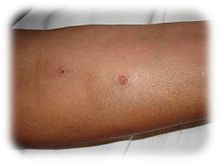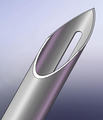Buttonhole puncture
The buttonhole puncture ( KLP ) ( engl. Buttonhole technique ) is a puncture technique on the dialysis uses, the exact to each treatment, the same puncture site of a native arteriovenous fistula. A scar cylinder is created in which the thrombus that has formed is repeatedly displaced during puncture. One speaks of a channel or tunnel through which the cannula is inserted, comparable to the insertion of an earring or piercing . Some centers in Europe use buttonhole puncture as the preferred method and also use the technique for initial punctures of newly created AV fistulas .
definition
Puncture of exactly the same puncture site, with the same angle of attack and the same cannula direction, through the existing puncture channel on each dialysis. After creating the puncture site and 6 to 9 punctures per buttonhole, you can usually switch to the buttonhole cannula.
history
Z. Twardowski first described his experience in puncturing the same puncture sites in a native AV fistula in 1977 and called this method the “constant-site” technique. Conventional cannulas were used as special buttonhole cannulas were not yet available. He published the first results of the "constant-site" technique in use on 16 patients in 1979. The results were described as a surprise and showed an easier, faster and more successful puncture, less pain perception, fewer bruises with a not significantly higher shunt infection rate .
advantages
The advantages of buttonhole puncture are stated:
- No aneurysm triggering
- Less puncture pain
- Ideal for short puncture distances
- Less bruises
- Method of choice for self-puncture
- Shorter impression times
- Decrease in fear of puncture failure
Puncture technique
The puncture differs in a few points from the conventional rope ladder puncture:
- Standardized position of the arm. (The arm positioning should be identical for each puncture, since the change in arm position leads to a displacement of the subcutaneous tissue.)
- Disinfection of the scab ( observing the exposure time).
- Aseptic and atraumatic scab removal. (The eschar is primarily considered to be infected. The eschar can be removed using fine, sterile splinter tweezers or a pink aspiration cannula. Complete removal of the eschar is essential, since the canal infection is still the most common complication of the technique.)
- Renewed disinfection of the scab-free puncture site.
- Insertion of the cannula into the puncture channel. (Experienced puncturers describe that the cannula finds its own way after being inserted into the canal. No greater pressure should be exerted. The cannula tip finds its way by grasping the cannula behind the wings on the tube and slowly pushing it forward in a rotating motion This prevents injuries to the connective tissue canal wall.)
- Fixation of the cannula according to the center standard.
Creation of a new puncture canal
The technique can be used with all native AV fistulas, regardless of whether forearm or upper arm shunt. The puncture sites are determined and punctured 6 to 12 times with a sharp cannula. These punctures should always be performed in the same way. That means: same arm position, same puncture direction, same puncture angle. To achieve this goal, it is recommended that max. 2 to 3 people perform the punctures in the canal formation phase. The following criteria and processes influence the layout and formation of the puncture channel:
- Functional AV fistula
- Intact skin at the puncture site
- Determine the optimal puncture site
- Identical arm positioning
- Easily accessible puncture area
- Free position of the cannula tip in the vessel lumen
- Subsequent functions first require the removal of the scab
- Once the canal is fully formed (primarily decreasing advancement resistance and easier removal of the puncture scab), the buttonhole cannula can be switched to.
Buttonhole cannula design
Conventional puncture cannulas have a facet cut . This means that one side of the cannula tip is sharply ground. The buttonhole cannula is less sharp, i.e. semi-sharp, with a rounded cannula tip.
Complications
The most common complication of buttonhole puncture is a canal infection (tunnel infection). Causes are incorrect, unhygienic removal of the scab and the introduction of germs into the tunnel, as well as disinfection errors. However, a lack of compliance on the part of the patient, such as poor body hygiene and scratching the scab with scab removal, should also be mentioned.
A trampoline effect occurs when the semi-sharp buttonhole cannula cannot be inserted into the finished tunnel. Alternatively, an experienced scorer only makes a second attempt.
A conventional, sharp cannula may be punctured once to reopen the canal. The event must be documented. Repeated puncturing with conventional cannulas increases the occurrence of complications such as tunnel enlargement, larger scab formation, tunnel bleeding and even tunnel infections.
Individual evidence
- ^ Z. Twardowski et al., 1977, Pol Arch Med Wewn 57: 205-214
- ↑ B. Spindler, buttonhole puncture spectrum of dialysis and apharesis, 9/2011, pp. 26–31.
- ↑ Z. Twardowski H Kubara, Different sites versus constant sites of needle insertion into arteriovenous fistulas for dialysis treatment by repeatet, Dialtranspl 8: 978-980, 1979
- ↑ AM Verhallen, MP Kooistra, BC van Jaarsveld: Cannulating in haemodialysis: rope-ladder or buttonhole technique? In: Nephrology Dialysis Transplantation . 2007, Volume 22: pp. 2601-2604. doi : 10.1093 / ndt / gfm043 . PMID 17557776 .
- ↑ LK Ball, L. Treat et al. a .: A multi-center perspective of the Buttonhole Technique in the Pacific Northwest. In: Nephrology Nursing Journal. Volume 34, Number 2, 2007 Mar-Apr, pp. 234-241, ISSN 1526-744X . PMID 17486957 .
- ↑ a b Vascular access for hemodialysis - Recommendations of the Care Working Group (GHEAP) 2012, p. 73, ISBN 3-00-029744-8




